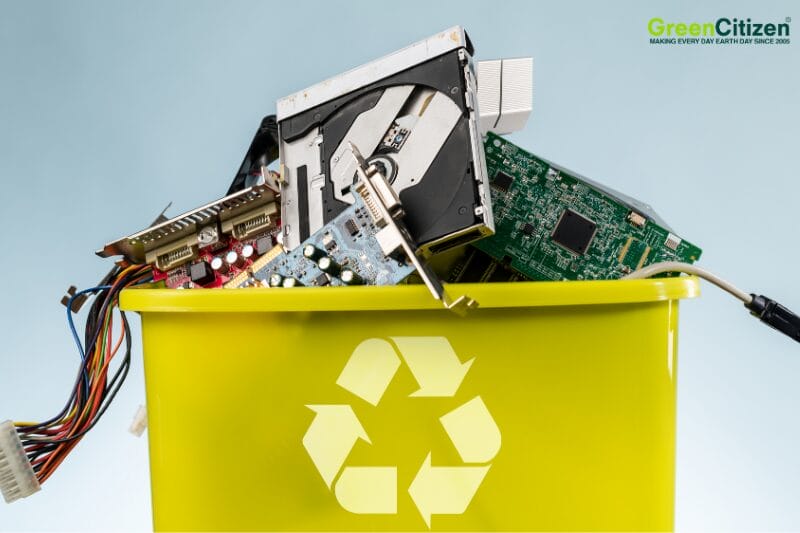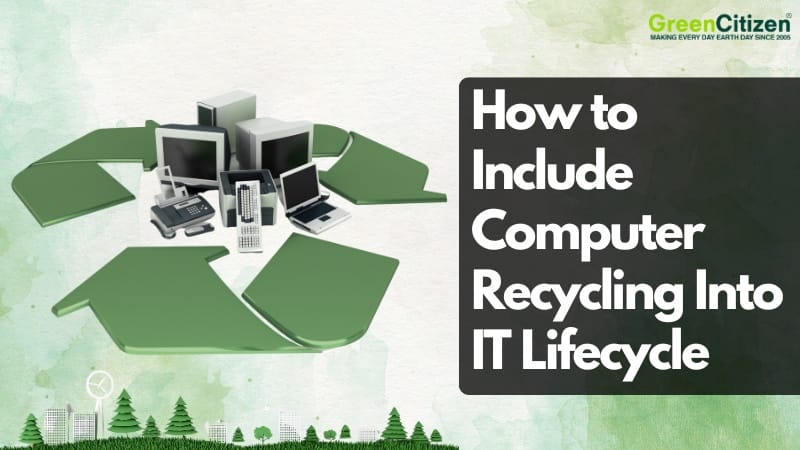For many Bay Area businesses, computer recycling still feels like an afterthought — something to worry about once devices pile up in storage rooms. But in today’s regulatory and sustainability-focused climate, it’s no longer enough to treat disposal as a side project. The smarter approach is learning how to include computer recycling into your IT lifecycle so it becomes a seamless, cost-saving, and compliance-friendly process.
By planning for recycling from the moment new equipment is purchased, companies can avoid surprise costs, reduce audit risks, and eliminate stockpiles of outdated devices.
More importantly, recycling becomes an integrated part of IT asset lifecycle management — alongside procurement, deployment, maintenance, and refresh cycles. For Bay Area firms facing strict California hazardous waste penalties of up to $70,000 per violation per day, embedding recycling into IT planning isn’t just good practice; it’s a business necessity.
Key Takeaway: How to Include Computer Recycling Into IT Lifecycle
Bay Area businesses can build computer recycling into their IT lifecycle by planning at procurement, tagging assets, flagging devices during maintenance, aligning pickups with refresh cycles, securing retirement with certified data destruction, and reporting results. This step-by-step process ensures compliance, reduces costs, protects data, and supports ESG goals.
Step 1: Plan Computer Recycling at the Procurement Stage
Recycling doesn’t start when a computer stops working — it starts the day you buy it. At the procurement stage, Bay Area businesses should set a plan for how those devices will be retired, recycled, and documented when their lifecycle ends. Doing this upfront avoids costly surprises and compliance headaches later.
Without a retirement plan, old computers often pile up in storage rooms, costing $2–$5 per square foot per month in Bay Area commercial real estate. Worse, when it comes time to dispose of them, companies may end up rushing into uncertified recycling, risking fines of up to $70,000 per violation per day under California law.
What to do:
- Select a certified recycling partner early: Choose who will manage end-of-life assets before deployment.
- Add recycling to your IT budget: Build expected recycling fees into total cost of ownership to avoid sticker shock later.
Benefit:
Procurement teams can set expectations for compliance and cost from the start, ensuring recycling isn’t treated as an afterthought.
👉 Pro Tip: By partnering with a local certified recycler like GreenCitizen upfront, businesses can align pickup schedules with future refresh cycles, saving logistics costs and avoiding disruptions.
Step 2: Asset-Tagging During Deployment
Most recycling problems don’t happen at disposal — they start at deployment. Without asset-tagging, devices get lost across departments or forgotten until audits. The fix is simple: tag and register devices as soon as they’re deployed.
Untracked devices become “orphans.” When refresh cycles arrive, IT managers scramble to match serial numbers or discover forgotten machines. Beyond inefficiency, these untagged computers can bypass secure recycling, creating data breach and compliance risks under HIPAA, PCI, or SOC 2.
What to do:
- Tag devices at deployment: Use barcodes or RFID tags linked to an IT asset management (ITAM) system.
- Record critical data: Serial number, assigned user/department, purchase date, warranty coverage, and expected retirement date.
- Set lifecycle reminders: Automate alerts for 3–5 year lifespans so recycling is pre-planned.
Benefit:
Accurate tracking ensures every computer can be identified and retired securely, with chain-of-custody documentation to back it up.
👉 Pro Tip: Sync ITAM records with your recycler’s reports. GreenCitizen, for example, provides itemized Certificates of Recycling and Data Destruction using GTAMS that match your internal database — making audits seamless.
Step 3: Build Computer Recycling Into IT Maintenance Cycles
IT maintenance reviews aren’t just for performance and patching — they’re checkpoints to plan for recycling. Treating audits as a place to flag aging equipment keeps retirement predictable.
Without proactive planning, outdated computers stockpile in storerooms. That leads to rush pickups, unplanned costs, and audit delays. Forgotten devices also risk slipping through without proper sanitization.

What to do:
- Audit with retirement in mind: Flag machines approaching their 3–5 year refresh point.
- Create a “ready for recycling” category: Add a column in ITAM to tag devices for upcoming retirement.
- Budget in advance: Use this visibility to allocate funds or book bulk pickups ahead of schedule.
Benefit:
Recycling becomes part of the routine. Instead of last-minute scrambles, IT managers can hand off devices smoothly with the right documentation.
👉 Pro Tip: Treat flagged devices like “pending liabilities.” The earlier they’re queued, the easier it is to align with refresh projects — saving 10–20% in logistics costs and freeing IT staff for core work.
Step 4: Align Computer Recycling with IT Refresh Cycles
Most Bay Area companies refresh computers every three to five years. Instead of letting old devices accumulate, the best approach is to schedule bulk recycling pickups alongside refresh rollouts.
Single-piece computer recycling multiplies transportation fees, coordination, and paperwork. Aligning pickups with refresh projects consolidates the process, reduces costs, and streamlines compliance reporting.
What to do:
- Plan disposal as part of refresh projects: Book a certified recycler for same-week pickup when new devices roll out.
- Bundle equipment: Collect desktops, laptops, and accessories together for bulk recycling.
- Match reports to IT records: Ensure the recycler’s certificates align with ITAM data for easy audit prep.
Benefit:
This approach cuts logistics costs, reduces staff workload, and ensures every device is tracked and retired securely in one sweep.
👉 Pro Tip: Treat recycling as a deliverable in refresh project plans. Adding it as the final step guarantees old machines leave as new ones arrive — with no hidden storage or compliance costs.
Step 5: Secure Computer Retirement with Documentation
At retirement, the priority shifts to data security and compliance. Simply handing off machines isn’t enough — businesses need certified processes and documentation.
Even after a factory reset, sensitive data remains accessible on hard drives and SSDs. Mishandled disposal can lead to data breaches and regulatory violations. Frameworks like HIPAA, PCI DSS, and SOC 2 all require proof of responsible IT asset disposal.
What to do:
- Require certified data destruction: Use recyclers following NIST 800-88 standards (clear, purge, or destroy).
- Obtain certificates: Always request Certificates of Data Destruction and Certificates of Recycling.
- Maintain chain-of-custody: Itemized reports should include serial numbers or asset tags to match ITAM records.
Benefit:
Documentation provides peace of mind and compliance evidence, while ESG teams gain measurable metrics for sustainability reporting.
👉 Pro Tip: Store certificates in the same repository as IT asset records. That way, if auditors or regulators request proof, you can deliver it instantly.
Step 6: Close the Loop on Computer Recycling with Reporting
Recycling isn’t complete until results are measured and shared. Reporting transforms IT recycling from a back-office task into a visible proof point of accountability and sustainability.
Investors, auditors, and customers expect evidence. Reporting on devices retired, pounds diverted, and secure data destruction builds trust, strengthens ESG reporting, and supports Scope 3 waste metrics.
What to do:
- Capture key metrics: Devices processed, total weight, disposition method (refurbished, shredded, recycled), batteries removed, turnaround time.
- Integrate with internal systems: Align recycler data with ITAM and sustainability frameworks like GRI 306 (Waste) or SASB standards.
- Publish results: Include recycling performance in ESG or CSR reports, or share progress internally via quarterly scorecards.
Benefit:
Closing the loop with reporting shows measurable progress. Instead of saying “we recycle,” businesses can prove it with data that resonates with stakeholders.
👉 Pro Tip: Convert certificates into metrics. For example: “In FY2024, our company recycled 480 desktops and diverted 3,950 lbs of e-waste from Bay Area landfills.” Simple, powerful, and audit-ready.
Partnering With GreenCitizen to Build Computer Recycling Into Your IT Lifecycle
Planning, tagging, auditing, refreshing, and reporting only work if you have a partner who can close the loop reliably. For Bay Area businesses, GreenCitizen provides the certified infrastructure, local expertise, and reporting systems that make computer recycling seamless across the IT lifecycle.
Why GreenCitizen:
- Full chain of custody: Our proprietary GreenCitizen Total Accountability Management System (GTAMS) tracks every device from pickup to final disposition, with itemized Certificates of Recycling and Certificates of Data Destruction.
- Data security guaranteed: Drives are wiped, purged, or physically destroyed following NIST 800-88 standards, keeping sensitive information safe.
- Audit-ready reporting: Recycling data integrates directly into ESG frameworks, giving businesses credible metrics for Scope 3 waste reporting and sustainability disclosures.
- Local presence, easy access: Businesses can schedule pickup service across San Francisco, San Jose, Oakland, Palo Alto, Mountain View, and beyond.
- Certified and accountable: We only work with R2 and e-Stewards certified partners and process everything domestically to ensure compliance with California and federal regulations.
By embedding GreenCitizen into your IT lifecycle, you eliminate the risks of uncertified haulers or ad-hoc disposal. Instead, every stage — from procurement planning to reporting — is supported with certified processes, transparent documentation, and measurable results.
Closing the Loop on Computer Recycling in Your IT Lifecycle
Building computer recycling into your IT lifecycle isn’t just about responsible disposal — it’s about creating a predictable, compliant, and cost-efficient process from day one. By planning at procurement, tagging assets at deployment, auditing during maintenance, aligning with refresh cycles, securing retirement, and reporting results, Bay Area businesses can transform recycling into a seamless part of IT operations.
With the right partner, this lifecycle becomes effortless. GreenCitizen provides the certifications, chain-of-custody tracking, and audit-ready reporting that help businesses protect data, satisfy regulators, and meet sustainability goals. In the Bay Area — where innovation, compliance, and accountability set the bar — responsible computer recycling is no longer optional. It’s the smarter, safer, and more sustainable way forward.
